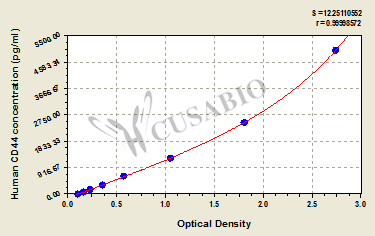The product CSB-E11846h is a sandwich ELISA kit developed to measure concentrations of human CD44 in serum, plasma, cell culture supernates, or tissue homogenates. This assay uses the sandwich enzyme immunoassay technique in combination with the enzyme-substrate chromogenic reaction to quantify the analyte in the sample. The color develops positively to the amount of CD44 in samples. The color intensity is measured at 450 nm via a microplate reader.
CD44 is a cell surface adhesion molecule overexpressed on cancer stem cells. Upon binding to its ligand hyaluronic acid (HA), CD44 is activated leading to the activation of cell signaling pathways that induce proliferation, increase cell survival, regulate cytoskeletal alterations, and enhance cellular motility. The interaction of CD44 with hyaluronan also contributes to tumor development, metastasis, and expression of the chemoresistant phenotype. In addition to hyaluronan uptake and degradation, CD44 also participates in angiogenesis, wound healing, as well as tissue formation and patterning. CD44 variants (CD44v) are up-regulated in neoplasia and involved in tumor metastasis and aggression.






